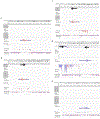RNA Next-Generation Sequencing and a Bioinformatics Pipeline to Identify Expressed LINE-1s at the Locus-Specific Level
- PMID: 31157783
- PMCID: PMC7371004
- DOI: 10.3791/59771
RNA Next-Generation Sequencing and a Bioinformatics Pipeline to Identify Expressed LINE-1s at the Locus-Specific Level
Abstract
Long INterspersed Elements-1 (LINEs/L1s) are repetitive elements that can copy and randomly insert in the genome resulting in genomic instability and mutagenesis. Understanding the expression patterns of L1 loci at the individual level will lend to the understanding of the biology of this mutagenic element. This autonomous element makes up a significant portion of the human genome with over 500,000 copies, though 99% are truncated and defective. However, their abundance and dominant number of defective copies make it challenging to identify authentically expressed L1s from L1-related sequences expressed as part of other genes. It is also challenging to identify which specific L1 locus is expressed due to the repetitive nature of the elements. Overcoming these challenges, we present an RNA-Seq bioinformatic approach to identify L1 expression at the locus specific level. In summary, we collect cytoplasmic RNA, select for polyadenylated transcripts, and utilize strand-specific RNA-Seq analyses to uniquely map reads to L1 loci in the human reference genome. We visually curate each L1 locus with uniquely mapped reads to confirm transcription from its own promoter and adjust mapped transcript reads to account for mappability of each individual L1 locus. This approach was applied to a prostate tumor cell line, DU145, to demonstrate the ability of this protocol to detect expression from a small number of the full-length L1 elements.
Figures






Similar articles
-
A comprehensive approach to expression of L1 loci.Nucleic Acids Res. 2017 Mar 17;45(5):e31. doi: 10.1093/nar/gkw1067. Nucleic Acids Res. 2017. PMID: 27899577 Free PMC article.
-
Truncated ORF1 proteins can suppress LINE-1 retrotransposition in trans.Nucleic Acids Res. 2017 May 19;45(9):5294-5308. doi: 10.1093/nar/gkx211. Nucleic Acids Res. 2017. PMID: 28431148 Free PMC article.
-
Sequencing, identification and mapping of primed L1 elements (SIMPLE) reveals significant variation in full length L1 elements between individuals.BMC Genomics. 2015 Mar 21;16(1):220. doi: 10.1186/s12864-015-1374-y. BMC Genomics. 2015. PMID: 25887476 Free PMC article.
-
Utility of next-generation RNA-sequencing in identifying chimeric transcription involving human endogenous retroviruses.APMIS. 2016 Jan-Feb;124(1-2):127-39. doi: 10.1111/apm.12477. APMIS. 2016. PMID: 26818267 Review.
-
The Human Long Interspersed Element-1 Retrotransposon: An Emerging Biomarker of Neoplasia.Clin Chem. 2017 Apr;63(4):816-822. doi: 10.1373/clinchem.2016.257444. Epub 2017 Feb 10. Clin Chem. 2017. PMID: 28188229 Free PMC article. Review.
Cited by
-
Comparative analysis on the expression of L1 loci using various RNA-Seq preparations.Mob DNA. 2020 Jan 6;11:2. doi: 10.1186/s13100-019-0194-z. eCollection 2020. Mob DNA. 2020. PMID: 31921361 Free PMC article.
-
Analysis of epigenetic features characteristic of L1 loci expressed in human cells.Nucleic Acids Res. 2022 Feb 28;50(4):1888-1907. doi: 10.1093/nar/gkac013. Nucleic Acids Res. 2022. PMID: 35100410 Free PMC article.
-
A novel role of TRIM28 B box domain in L1 retrotransposition and ORF2p-mediated cDNA synthesis.Nucleic Acids Res. 2023 May 22;51(9):4429-4450. doi: 10.1093/nar/gkad247. Nucleic Acids Res. 2023. PMID: 37070200 Free PMC article.
-
Tet1 Deficiency Leads to Premature Ovarian Failure.Front Cell Dev Biol. 2021 Mar 23;9:644135. doi: 10.3389/fcell.2021.644135. eCollection 2021. Front Cell Dev Biol. 2021. PMID: 33834024 Free PMC article.
-
Locus-specific LINE-1 expression in clinical ovarian cancer specimens at the single-cell level.Sci Rep. 2024 Feb 21;14(1):4322. doi: 10.1038/s41598-024-54113-w. Sci Rep. 2024. PMID: 38383551 Free PMC article.
References
Publication types
MeSH terms
Substances
Grants and funding
LinkOut - more resources
Full Text Sources
